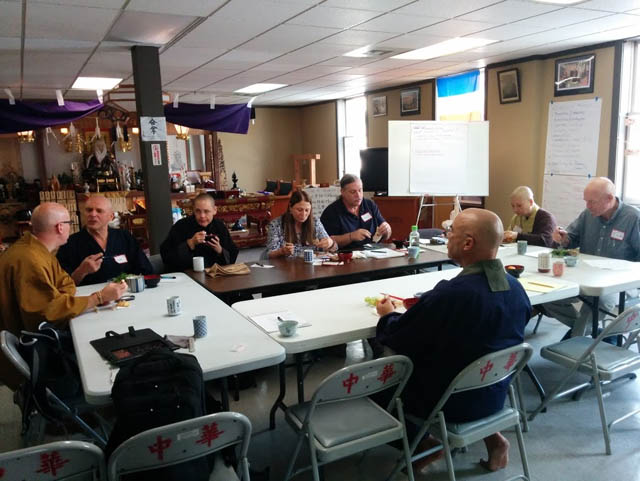Seattle Regional Meeting of Buddhist Teachers
Written by: George Draffan

Seattle meeting participants included (from left): Kanjin Cedarman, Eshin Godfrey, Ann Tjhung, Kathy Adams, Mark Winwood, Genjo Marinello, Guo Cheen, and Timothy O’Brien.
Photo by: George Draffan
Fifteen teachers from varied Chinese, Zen, Tibetan, vipassana, and non-sectarian organizations gathered at the Choeizan Enkyoji Nichiren Buddhist Temple in Seattle on Oct. 4, for the annual teachers’ meeting.
A similar meeting was underway at the same time in Portland, a new and more local strategy by Northwest Dharma Association to better support the region’s Buddhist teachers.
The Portland meeting was hosted by the Portland Insight Meditation Community.
Located in an old brick building in the heart of Seattle’s International District, the Nichiren Buddhist temple, with an ornate shrine, represents the ancient Nichiren Shu lineage from Japan. The young American priest Kanjin Cedarman provides a unique, welcoming presence that bridges the distance between ancient East and modern West.
At the beginning of the meeting, Northwest Dharma Association Administrator Timothy O’Brien, and Association Vice President Damien Abel, introduced the new Northwest Dharma Mahasangha initiative in which NWDA will support local conversations by Buddhist leaders and practitioners.
The formats and topics of the Mahasangha meetings will be open to each meeting’s participants’ imagination. The recurring themes arising during the Seattle meeting included sangha diversity, teacher-student ethics, discovering the common ground of different Buddhist traditions, and exploring opportunities for social service. Several temples have already offered to host meetings in upcoming months.
October 4 marked the 13th Annual Regional Meeting of Buddhist Teachers sponsored by the Northwest Dharma Association.
The meetings are open to monastics, teachers, and lay leaders of any Buddhist group in the region, as a way for teachers to meet each other and explore areas of mutual interest and concern. Some of the topics suggested by the teachers meeting this year included:
- Promoting diversity of ethnicity, gender, and age.
- Encouraging interaction among different Buddhist traditions. What makes us “Buddhist?”
- How teachers can work with different levels of students simultaneously, providing them all with practice and study opportunities.
- How teachers should work with people who want to keep “shopping around.”
- The role of Buddhist communities in a time of environmental crisis; the simple way of life of early Buddhist communities, and its relevance today.
- Adapting and applying the ethical precepts to the contemporary world.
- Opportunities for Buddhist groups to develop senior living and co-housing communities.
- The observable behavioral competencies that constitute compassion, and how they are trained and practiced.
- How to develop dharma communities that truly thrive.
